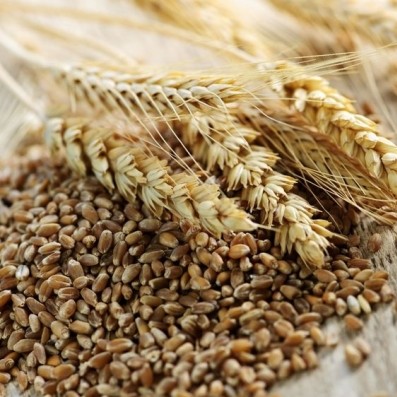Whole Grains
What are Whole Grains?
Whole grains are cereal grains which contain the intact, ground, cracked or flaked kernel or seed of the grain as well as the endosperm, germ and bran.1 The American Association of Cereal Chemists International (AACCI) defines whole grains as “The intact, ground, cracked or flaked caryopsis, whose principal anatomical components – the starchy endosperm, germ and bran – are present in the same relative proportions as they exist in the intact caryopsis.”
Whole grains are an ingredient found in many products, including but not limited to:2
- Crackers
- Breads
- Cereals/granola bars
- Tortillas
- Pasta
- Cookies
- Cakes
Origin
Whole grains became a part of the human diet approximately 10,000 years ago, with the emergence of agriculture. For the past 3,000 to 4,000 years, a majority of the world’s population has consumed whole grains as a significant portion of their diet.
In the United States and Canada, wheat, oats, barley and rye were harvested as staple foods as early as the 1700’s. It wasn’t until the invention of the roller mill in the late 1800’s that it was efficient to separate the bran and germ from the endosperm; increased use of the roller mill led to an increase in demand for refined grain products and, consequently, a whittling of the demand and consumption of whole grain.3
Nutrition
Whole grains are rich in vitamins, minerals and dietary fiber.4 They provide a good source of phytochemicals and micronutrients, B vitamins, magnesium and selenium.5
Commercial Production
Cereal grain kernels are composed of three main parts: the endosperm, bran and germ. Most cereal products – such as white bread or pasta – are made with kernels or flour that have had the bran and germ removed. The bran and germ are the highest fiber parts of the kernel.6 In order to be considered a whole grain, the bran and germ must be present in addition to the endosperm. In the production of whole grain flours of wheat, rye, barley, oat and maize, the kernels are broken, separated into milling streams containing endosperm rich white flour, germ and bran fractions and then combined in fixed ratios.
Application
Whole grains are composed of bran, constituting 3 – 30% of the grains total weight; germ, constituting 4 – 17% of the grains total weight; endosperm, constituting 65 – 75% of the grains total weight.7
They are categorized into two primary types: true cereals and pseudo-cereals. True cereals include wheat, faro, rice, barley, corn, rye, oats, millets, sorghum and wild rice, among others. Pseudo-cereals include amaranth, buckwheat and quinoa.
The labeling requirements for a product to qualify as “whole grain” varies significantly by region. In Canada, the United States and the United Kingdom, manufacturers are allowed to reference whole grains but are not required to disclose the amount of whole grain contained in the food product.8
Because of the ambiguity surrounding food labeling for whole grains, it can be difficult to determine whether a given product contains whole grains and, if so, what proportion of the product consists of whole grains. This poses an issue in nutritionally controlled environments, such as schools, where it may be difficult to ensure students are receiving the FDA recommended amount of whole grains. 9
FDA Regulation
The FDA is in charge of regulating whole grains and what constitutes a whole grain product. In order to be labeled a whole grain food, the FDA requires the product to contain 51% or more whole grains by weight. For more information on FDA requirements, click here.
References
- Jones, J., & Engleson, J. (2010). Whole Grains: Benefits and Challenges. Annual Review of Food Science and Technology, 1, 19-40.
- Lafferty, Anne, Len Marquart, and Marla Reicks. “Hunting for Whole Grains: A Supermarket Tour.” Journal of Nutrition Education and Behavior 38.3 (2006): 197-198.
- Slavin, Joanne. “Whole Grains and Human Health.” Nutrition Research Reviews, Department of Food Science and Nutrition, University of Minnesota (2004): 1-2. Wholegrainscouncil.org.
- Jonnalagadda, Satya S., Lisa Harnack, Rui Hai Liu, Nicola McKeown, Chris Seal, Simin Liu, and George C. Fahey. “Putting the Whole Grain Puzzle Together: Health Benefits Associated with Whole Grains—Summary of American Society for Nutrition 2010 Satellite Symposium 1 2 3.” The Journal of Nutrition 141.5 (2011): 1011S-1022S.
- “Whole Grains, Legumes, and Health.” Journal of Nutrition and Metabolism 2012.2012 (2012).
- van der Kamp, Jan Willem, Kaisa Poutanen, Chris J. Seal, and David P. Richardson. “The HEALTHGRAIN definition of ‘whole grain’.” Food & Nutrition Research 58 (2014).
- Franz, Mary, and Laura Sampson. “Challenges in developing a whole grain database: Definitions, methods and quantification.” Journal of Food Composition and Analysis 19 (2006): S38-S44.
- Sumanac, Dunja, Rena Mendelson, and Valerie Tarasuk. “Marketing whole grain breads in Canada via food labels.” Appetite 62 (2013): 1-6.
- Chu, Yen Li, Mary Orsted, Len Marquart, and Marla Reicks. “School Foodservice Personnel’s Struggle with Using Labels to Identify Whole-Grain Foods.” Journal of Nutrition Education and Behavior 44.1 (2012): 76-84.


